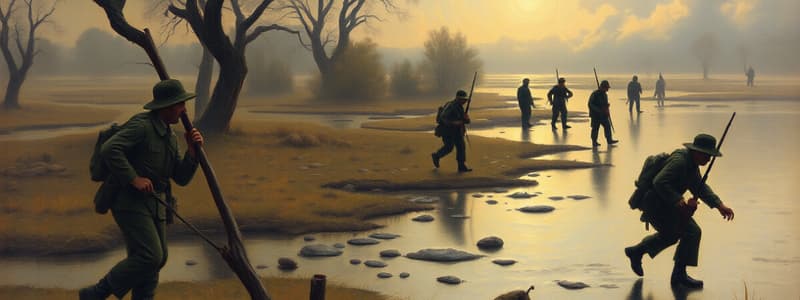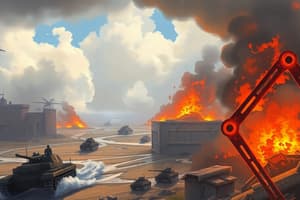Podcast
Questions and Answers
The Allies included Germany and Austria-Hungary during the First World War.
The Allies included Germany and Austria-Hungary during the First World War.
False (B)
The USA entered the First World War in April 1917.
The USA entered the First World War in April 1917.
True (A)
Italy entered the First World War in May 1915.
Italy entered the First World War in May 1915.
True (A)
The German advance was halted by unexpectedly weak Belgian resistance.
The German advance was halted by unexpectedly weak Belgian resistance.
The central powers included countries such as France and Japan.
The central powers included countries such as France and Japan.
The First World War was expected to last only until Christmas 1914.
The First World War was expected to last only until Christmas 1914.
An armistice was signed on 11 November 1918, marking the end of combat in the war.
An armistice was signed on 11 November 1918, marking the end of combat in the war.
The British navy played a significant role in blockading German ports during the war.
The British navy played a significant role in blockading German ports during the war.
The Germans successfully captured Paris within six weeks as initially planned.
The Germans successfully captured Paris within six weeks as initially planned.
The Battle of the Marne was significant as it marked a decisive turning point for the French against the Germans.
The Battle of the Marne was significant as it marked a decisive turning point for the French against the Germans.
Russia successfully invaded both Austria and Germany simultaneously without any issues.
Russia successfully invaded both Austria and Germany simultaneously without any issues.
Turkey's entry into the war created challenges for Russia by threatening their supply routes.
Turkey's entry into the war created challenges for Russia by threatening their supply routes.
The German forces at Tannenburg faced little to no resistance from the Russians.
The German forces at Tannenburg faced little to no resistance from the Russians.
Despite having over six million men mobilized in 1914, a significant number of Russian soldiers were without rifles.
Despite having over six million men mobilized in 1914, a significant number of Russian soldiers were without rifles.
The eastern front experienced a clear victory for the Russians against the Germans throughout 1914.
The eastern front experienced a clear victory for the Russians against the Germans throughout 1914.
The stalemate in the west continued in 1915 despite several attempts to break the trench lines.
The stalemate in the west continued in 1915 despite several attempts to break the trench lines.
The attack resulted in 20,000 British troops being killed on the first day.
The attack resulted in 20,000 British troops being killed on the first day.
Haig called off the attack after the first day due to heavy casualties.
Haig called off the attack after the first day due to heavy casualties.
The Allies made significant advances of more than seven miles during the battle.
The Allies made significant advances of more than seven miles during the battle.
The Germans suffered approximately 650,000 killed or wounded during the battle.
The Germans suffered approximately 650,000 killed or wounded during the battle.
Haig was widely praised for his innovative tactics during the battle.
Haig was widely praised for his innovative tactics during the battle.
W.J. Laffin wrote a book titled British Butchers and Bunglers of World War 1.
W.J. Laffin wrote a book titled British Butchers and Bunglers of World War 1.
Haig showed receptiveness to new techniques in the 1918 campaign.
Haig showed receptiveness to new techniques in the 1918 campaign.
The horrors of the Somme led to the resignation of British Prime Minister Asquith in 1916.
The horrors of the Somme led to the resignation of British Prime Minister Asquith in 1916.
David Lloyd George succeeded Asquith as British prime minister in December 1916.
David Lloyd George succeeded Asquith as British prime minister in December 1916.
The Russians achieved a significant victory against the Austrians in June 1916 by advancing 200 miles.
The Russians achieved a significant victory against the Austrians in June 1916 by advancing 200 miles.
Lloyd George improved the supply of munitions as Minister of Munitions before becoming Prime Minister.
Lloyd George improved the supply of munitions as Minister of Munitions before becoming Prime Minister.
The Battle of Trafalgar was fought between the British fleet and the German fleet.
The Battle of Trafalgar was fought between the British fleet and the German fleet.
The Dreadnought fleets of Germany and Britain engaged in numerous naval battles during World War I.
The Dreadnought fleets of Germany and Britain engaged in numerous naval battles during World War I.
The British Admiral Jellicoe was known for being particularly aggressive in naval strategy during the war.
The British Admiral Jellicoe was known for being particularly aggressive in naval strategy during the war.
The Germans had an advantage in Dreadnoughts with 27 compared to the British 16.
The Germans had an advantage in Dreadnoughts with 27 compared to the British 16.
In 1916, the Romanians invaded Austria, which led to a rescue by the Germans.
In 1916, the Romanians invaded Austria, which led to a rescue by the Germans.
The Battle of Jutland was a decisive victory for the German fleet.
The Battle of Jutland was a decisive victory for the German fleet.
After the Battle of Jutland, the German High Seas Fleet continued to engage with the British navy regularly.
After the Battle of Jutland, the German High Seas Fleet continued to engage with the British navy regularly.
Unrestricted submarine warfare began in January 1917 as a response to food shortages caused by the British blockade.
Unrestricted submarine warfare began in January 1917 as a response to food shortages caused by the British blockade.
By April 1917, Germany successfully sank 430 ships during its submarine campaign.
By April 1917, Germany successfully sank 430 ships during its submarine campaign.
The British blockade had no significant impact on Germany's food supply during the war.
The British blockade had no significant impact on Germany's food supply during the war.
The introduction of the convoy system was suggested by Lloyd George to protect merchant ships.
The introduction of the convoy system was suggested by Lloyd George to protect merchant ships.
Admiral von Scheer underestimated the number of British ships that would engage during the Battle of Jutland.
Admiral von Scheer underestimated the number of British ships that would engage during the Battle of Jutland.
The German strategy was focused on defeating the British fleet at the Battle of Jutland.
The German strategy was focused on defeating the British fleet at the Battle of Jutland.
Flashcards are hidden until you start studying
Study Notes
The First World War: 1914-1918
- Allied Powers: Britain, France, Russia, Italy, Serbia, Belgium, Romania, USA, Japan
- Central Powers: Germany, Austria-Hungary, Turkey, Bulgaria
The War Begins: 1914
- Western Front: German advance slowed by Belgian resistance; British Expeditionary Force able to land and organize.
- Schlieffen Plan: Germany's plan to quickly defeat France failed; German advance was slow, and they were pushed back by the French at the Battle of the Marne.
- Eastern Front: Russia mobilized quickly but made the mistake of attacking both Austria and Germany.
- Russian Losses: Defeats at Tannenburg and the Masurian Lakes resulted in heavy losses of equipment and ammunition, leaving them weakened.
- Turkish Entry: Turkey's involvement cut off Russia's vital supply route through the Black Sea.
- Serbian Success: The Serbs managed to defeat an Austrian invasion, boosting Allied morale.
Stalemate and Turning Points: 1915 - 1918
- Western Front Stalemate: Trench warfare emerged, with devastating casualties during attacks like the Battle of the Somme (1916).
- The Battle of the Somme: British casualties were heavy, leading to criticism of generals like Haig for their reliance on frontal attacks.
- Eastern Front Success: The Russians launched a successful offensive against Austria in 1916 (Brusilov Offensive ).
- David Lloyd George: Became British Prime Minister in 1916, introducing reforms to improve the war effort, including the Ministry of Munitions.
- Naval Warfare: The Battle of Jutland (1916), the major naval clash, ended indecisively.
- Unrestricted Submarine Warfare: Germany's attempt to sink all ships in the Atlantic nearly succeeded, putting Britain under severe strain.
- Convoy System: Introduced by Lloyd George, helped protect merchant ships from German submarines.
- American Entry: USA joined the Allied Powers in April 1917, providing vital support.
- German Exhaustion: By late summer 1918, Germany was nearing exhaustion due to heavy losses and the British blockade.
- Armistice: Signed on November 11, 1918, ending the war.
The Treaty of Versailles
- Controversial peace settlement signed in 1919, imposing harsh terms on Germany.
Studying That Suits You
Use AI to generate personalized quizzes and flashcards to suit your learning preferences.




